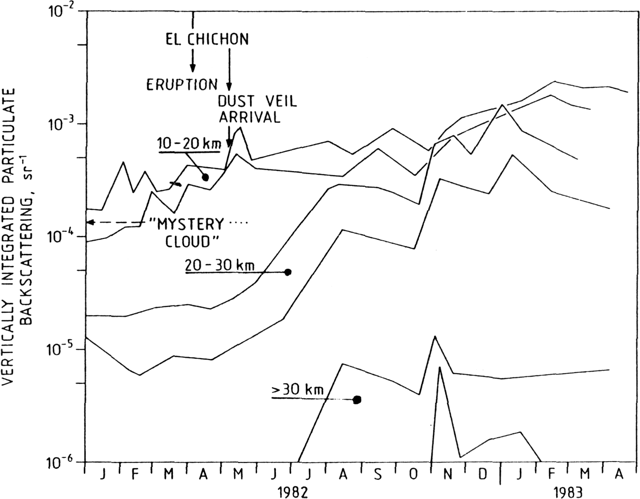Report on Atmospheric Effects (1980-1989) — November 1982

Atmospheric Effects (1980-1989)
Scientific Event Alert Network Bulletin, vol. 7, no. 11 (November 1982)
Managing Editor: Lindsay McClelland.
Atmospheric Effects (1980-1989) Lidar data from Germany and Hawaii; visual observations
Please cite this report as:
Global Volcanism Program, 1982. Report on Atmospheric Effects (1980-1989) (McClelland, L., ed.). Scientific Event Alert Network Bulletin, 7:11. Smithsonian Institution.
Atmospheric Effects (1980-1989)
All times are local (unless otherwise noted)
Data from ground-based lidar distant from El Chichón indicated that the dense portion of the stratospheric cloud ejected 4 April was spreading slowly northward. However, at low latitudes, where dense aerosols have been observed since shortly after the eruption, both the altitudes and concentrations of the strongest layers have decreased noticeably in November.
During the late October-early November NASA flight between 46°N and 46°S the dense portion of the cloud terminated at 6-10°S and 30-37°N. In some areas, the edge was quite abrupt, almost cliff-like, but in other regions, it was more gradual. The N boundary of the dense aerosols was at 35-37°N in late October, but at the time of the return flight in early November an arctic air mass had pushed it back to about 30°N, its approximate July position. Peak backscattering ratios were about half of those measured in July, but the cloud had become more homogeneous. By mid to late November, however, ground-based lidar showed that the dense cloud had advanced significantly farther N.
The following is from a report from Reinhold Reiter. "Short-interval lidar observations by the Fraunhofer-Institut für Atmospharische Umwelforschung, Garmisch-Partenkirchen, West Germany have been made since October 1976. Our first lidar sighting of an aerosol cloud attributed to the El Chichón activity was on 3 May at 15-16 km altitude (figure 1). This layer, with a scattering ratio of 3 (ratio of total to molecular backscattering) at 0.69 µm (ruby wavelength) was clearly distinguishable from the layer produced by the as yet unknown eruption in late December 1981 or early January 1982 (the so-called "mystery cloud"). From 11 May on, a broad layer between 10 and 20 km had developed with a backscattering maximum at 18 km. This layer remained very steady throughout the summer months. The maximum scattering ratio of 8 was observed 16 May; later on the layer showed values of 2-3. This layer, transported by the stratospheric westerlies, was joined by aerosol layers after the end of May that were carried by the stratospheric summer easterlies above 20 km. In the height range 20-25 km, the aerosol concentrations fluctuated drastically (figure 1) and not before mid-August had a rather homogeneous aerosol layer developed. The highest scattering ratio of 14 was observed with a height resolution of 600 m at 24.6 km on 1 August. After mid-October the double structure merged into a broad layer between 13 and 25 km, which can be explained by the change of the stratospheric wind pattern to the winter regime with westerlies throughout this height range.
"In November the stratospheric aerosol again changed its structure because of the arrival of the uppermost El Chichón clouds. Above 25 km, 2 new layers could be observed with scattering ratios of about 3, one centered at about 27 km, the other centered at about 30 km, tailing off to 35 km."
In Hawaii, lidar measurements showed a gradual decrease in total integrated backscatter until 3 December, when a hole appeared in in the aerosol layers at 26 km altitude, dropping integrated backscatter by nearly a factor of 2. Preliminary data from 10 December measurements indicates a return to a pattern similar to that of late November. The lower stratospheric layer first observed there in October was very strong in mid-November, but had nearly disappeared by the end of the month. In Hampton, Virginia increasingly strong backscattering ratios (twice those previously recorded at this latitude) at high altitudes were measured in November, showing that northward spread of the dense portion of the cloud had resumed, but lower stratospheric layers like those detected from Hawaii were not observed.
Unusual sunrises and sunsets were seen in Japan, Saudi Arabia, and Germany. Toshio Fujita reported fiery red glows and unusual twilights from various locations in Japan since 17 May. These were seen as far N as Sendai (38.27°N, 140.90°E) in late October. During the autumn, evening glows have been more brilliant than usual at Sapporo (43.05°N, 141.33°E). Many of these observations corresponded with detection of increased aerosols at 25-27 km altitude by the Meteorological Research Institute lidar (36°N, 140°E). Backscattering ratios ranged from 30-150. Small pale brownish halos often surrounded the moon, with diffused light extending 3-5 diameters. In Saudi Arabia, Edward Brooks continued to see long and unusually-colored dawns and twilights through early December, but noted considerable day-to-day variation. He could often see distinct bands of volcanic material (27 and 29 October, 5, 6, 11, 14-15, 17, 24, and 27 November, and 3-4 December). After sunset on 5 November, a SSW-NNE band of ash was illuminated after cirrus clouds (in the upper troposphere) had lost their illumination, indicating that the ash was at stratospheric altitudes. Separate tropospheric and stratospheric layers were illuminated before sunrise 3 December.
Information Contacts: P. McCormick and W. Fuller, NASA; R. Reiter, Garmisch-Partenkirchen, W. Germany; T. DeFoor, MLO; M. Hirono, Kyushu Univ., Japan; S. Hayashida, Nagoya Univ., Japan; T. Fujita, Meteorological Research Inst., Japan; E. Brooks, Saudi Arabia; A. Strong, NOAA.

